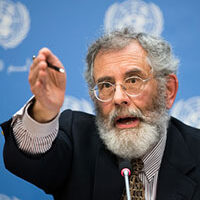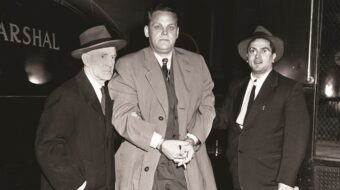
Al Marder, a stalwart of the U.S. peace movement and prominent figure in the Communist Party USA, Marder passed away Dec. 19, 2023, at the age of 101. In some ways, the story of his life reads like a serial thriller, with plenty of comedy and tragedy, victories and defeats.
As a teenager, he would sneak out of his parents’ house in a working-class neighborhood of New Haven, Conn., early in the morning to meet his good friend Sid Taylor, pushing the family car down the road before starting it so as not to waken his parents. They would distribute fliers and Daily Worker newspapers to workers arriving and leaving plant gates at Sargent and Co., after which they would reverse course and Al would sneak back into the house.
Years later, his mother revealed that his parents were in fact aware of his goings-on.
What’s remarkable about Al Marder during the 50 years I knew him was the urgency with which he constantly raised the necessity of opposing war and injustice. What’s remarkable is that he combined his deep historical analysis of current events with demands for action to address them. What’s remarkable is that he didn’t hesitate to press comrades up and down the ladder to act for peace and racial justice, to reach for unity with the broad people’s movements.
Al Marder entered the fight for justice and peace when he was 14 years old, the height of the Great Depression. He saw families being evicted, his own included, and he saw Communists moving their furniture back into tenants’ houses. He wasn’t alone. The nation was demanding peace. Workers were struggling for their rights and moving unionization to the fore.
Peace, he said, was a central demand of the Communist Party in the 1930s.
He became an organizer for the Young Communist League (YCL), becoming a leader in the group at age 16. Al began to connect the anti-Semitism that his family, Jewish immigrants from Ukraine, experienced with the prevalent anti-Black racism. He found that Communists modeled equal treatment of everyone.
At the New Haven Peoples Center, Al found his milieu. This community center had been bought by immigrant, socialist-oriented Jewish tradesmen for their own families and the broader community. There, Al participated in creating the first integrated theater group, the Unity Players, which, among others, performed Plant in the Sun in a tournament at the Yale Drama School, which they won, and in union halls throughout Connecticut.
Through the Peoples Center, Al also managed the YCL baseball team, the Redwings, the first integrated team in New Haven, built campaigns to integrate the city’s bus drivers’ union, and, with other young Communists, organized an evening college for workers through the New Haven Teachers College. Eventually, Al would become the president of the non-profit that runs the Peoples Center.
Al once shared a scary story of his time as a U.S. soldier during World War II. He was alone on a scouting mission in Austria when he heard the rumble of tanks and trucks he thought were German. He dove into a ditch alongside the road to hide, frightened of being captured. The convoy stopped by him, motors running, but the soldiers who exited the vehicles and spotted him weren’t speaking German. To his surprise, they spoke Russian. Al was perhaps the first G.I. to experience greeting and being warmly greeted by his Soviet counterparts coming from the east to liberate Austria.
On other occasions in the European theater, Al demanded that Black soldiers be able to sit with their white counterparts in movie theaters.
As German town after town was liberated by Allied troops, Al was assigned the task of seeking out non-Nazis to govern those cities. He did and, to his surprise, found anti-Nazis living among the population. Often, they were Communists who had survived the war in hiding.
After World War II ended, Al returned to union organizing in Connecticut and to study at the University of Connecticut, organizing his fellow students along the way. He was hopeful that the founding of the United Nations would bring about peace and an end to colonialism.
But after the war, the U.S. turned its big guns on its former ally, the Soviet Union, and with McCarthyism, attacked the progressive movements at home.
In 1954, one of eight charged in the Smith Act witch hunts in Connecticut for thinking communist thoughts, Al had to leave his family and go underground. Eventually caught, he was tried and acquitted, but not without serious consequences to many lives.
In the 1970s and ’80s, Al became a leader in the peace movement as the president of the U.S. Peace Council and vice president of the World Peace Council, positions he actively held until the end of his life.
A prime organizer of the anti-apartheid struggle in Connecticut, Marder helped create and lead the City of New Haven Peace Commission in 1988 and continued in the years that followed. Among other things, the Commission arranged for annual peace marches among city high school students, planted trees, and laid plaques in public parks and on school and library grounds on the International Day of Peace, and created a U.N.-recognized Peace Garden.
The Peace Commission introduced resolutions into the New Haven City Council, the Board of Alders, calling for abolition of nuclear weapons and moving money from war spending to human needs. On three occasions, the resolutions became ballot initiatives that won overwhelming approval from the city’s voters.
As a result of these activities, New Haven was invited to join the U.N.-sponsored International Association of Peace Messenger Cities, of which Al Marder was president for 12 years, the only non-mayor to hold that position.
Urged in 1987 by African American school board president, minister, and friend Rev. Edwin Edmonds, Al founded the Connecticut Amistad Committee, Inc., in the spirit of the original 1839 Amistad Committee, the first integrated abolitionist organization.
Under Al’s tutelage, the contemporary Committee lifted the story of the Mende people captured by Spain who revolted on the ship taking them to slavery and ended up in New Haven. Their fight for freedom, a victory stamped by a Supreme Court decision, was a shot in the arm for the abolitionist movement. Thanks to Al’s concerted efforts, a statue to Singbe Pieh, leader of the revolt, stands proudly in front of New Haven City Hall.
The 1997 Steven Spielberg movie Amistad dramatizes these events, while a replica of the Amistad ship has sailed the story around the world.
With his amazing memory, wry sense of humor, and easy laugh, Al was known to all as a great storyteller, attending to detail and drawing basic lessons. He shared many of those lessons with those who knew him—lessons they will carry with them forever.
We hope you appreciated this article. At People’s World, we believe news and information should be free and accessible to all, but we need your help. Our journalism is free of corporate influence and paywalls because we are totally reader-supported. Only you, our readers and supporters, make this possible. If you enjoy reading People’s World and the stories we bring you, please support our work by donating or becoming a monthly sustainer today. Thank you!












Comments